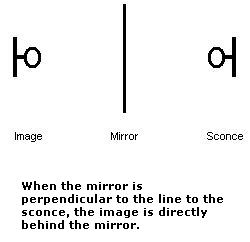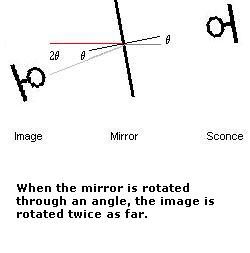Moving Reflections - Ghosts or Physics?
Recently, I was in Newport, RI, and I took a tour of Belcourt Castle. Originally the Summer House of Oliver Hazard Perry Belmont (who inherited a fortune from his father August Belmont, the Rothschild Banking representative in America), this large home is now the full time residence of the Tinney Family and their extensive, eclectic collection of antiques, art and artifacts.In a dining room, the tour guide showed us a “haunted mirror” (just one of a number of ghosts supposed to reside in the castle – the owners hold ghost tours during the summer). From behind the rope at one end of the room, we could see the haunted mirror hung against the far wall (about 5 meters – 16 feet - away from us). As we watched, the reflection in the mirror moved – that is, the reflected objects appeared to be moving from side to side, apparently shifting about 10cm in the mirror, due to the ghost.
Our guide assured us that the mirror was hung quite securely and no explan ation of the movement could be found. The Tinneys kept their mirror safely behind the rope, not allowing me check it out, and I decided not to annoy all those around me by lecturing on why I felt this was easily explained. The simple fact is, if you examine the angles and distances involved, making an object 5 meters away shift a distance of 10 centimeters does not require the mirror to shift upon the wall (in fact, if the mirror shifts exactly along the plane it lies in, the images will not move at all!) or to swing through a great angle. Rather, it requires only an almost imperceptible shift in the angle of the mirror upon the wall. A regular shifting that could be due to any number of causes; most likely the mirror was hung at a point where the natural vibration of the building set it swinging from side to side in a way that would be imperceptible except for the "amplification" provided by the physics of reflection.
ation of the movement could be found. The Tinneys kept their mirror safely behind the rope, not allowing me check it out, and I decided not to annoy all those around me by lecturing on why I felt this was easily explained. The simple fact is, if you examine the angles and distances involved, making an object 5 meters away shift a distance of 10 centimeters does not require the mirror to shift upon the wall (in fact, if the mirror shifts exactly along the plane it lies in, the images will not move at all!) or to swing through a great angle. Rather, it requires only an almost imperceptible shift in the angle of the mirror upon the wall. A regular shifting that could be due to any number of causes; most likely the mirror was hung at a point where the natural vibration of the building set it swinging from side to side in a way that would be imperceptible except for the "amplification" provided by the physics of reflection.
When the mirror swings through an angle of theta, the image moves an angle of 2 x theta - as shown in the second figure.
In order to make an object D m away from the mirror appear to shift by an amount ?x, the mirror needs to swing through an angle ? (in radians), given by:
- Deltax = 2 * theta* D
No comments:
Post a Comment